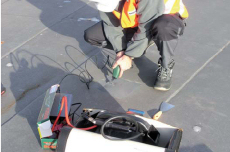A new method for the determination of chromium in anti-corrosion coatings of out-door steel objects has been developed by Swiss scientists that distinguish between hexavalent and trivalent chromium.
Background:Anti-corrosion coatings on out-door steel objects such as high-voltage electrical towers, bridges, pipelines and others may lead to environmental pollution with toxic heavy metals such as lead and chromium. Such pollution may be caused by normal weathering, or during renovation and remediation activities. In the past such heavy metal leaching into the environment has been quantified by analysing total element concentrations ignoring the decisive impact of species on the level of toxicity by techniques such as X-ray fluorescence with mobile instruments.
Anti-corrosion paintings used during the years 1970-1985 mainly contained Leadsilicochromate (PbCrO
4 * PbO/SiO
2) or zinc chromate (ZnCrO
4). A rough estimation for Switzerland tells that about 20-50 km
2 steel surface has been covered with about 10 tons of chromium-containing paint. Yearly renovation of such surfaces release up to 300 kg of hexavalent chromium. In order to limit environmental pollution, Swiss legislation requires that coatings contain less than 1g/kg hexavalent chromium.
The new method: Renato Figi
Renato Figi and his colleagues from
EMPA (Switzerland) report about a new method, measuring hexavalent chromium in anti-corrosion coatings. Essential part of the new method for chromium speciation analysis is the leaching step where chromium is extracted from pulverized paint with a hot (90-95°C) alkaline leaching solution consisting of sodium hydroxide and sodium carbonate.
Fig. 1: Sampling of the coating by mechanical scrapingCo-dissolved chromium(III) is precipitated with aluminium sulfate before determination of hexavalent chromium by the classical photometric method using diphenyl carbazide. Total chromium is determined by ICP-OES from a microwave assisted digestion of the pulverized paint.
The amount of chromium(III) is calculated from the difference between total chromium and hexavalent chromium. The reproducibility of 5 determinations of chromium coating on steel was in the range of 5.1-11,5% and the recovery of Cr(VI) was in the range of 86-99%. Using this robust method, the decision whether a coating has to be replaced can be taken timely and reliably.
Translated and adapted from source: Michael Sperling
Source:
EMPA The original publication
The original publication
Renato Figi, Oliver Nagel, Martin Tuchschmid,
Neue Methode zur quantitativen Bestimmung von toxischem Chrom(VI) in Korrosionsschutz-beschichtungen freistehender Stahlobjekte, Wasser Energie Luft - Eau Energie Air (ISSN 0377-905X), 100/2 (2008) 137-140.
available from EMPA Related studies
Related studies
David E. Harrington, J.S. Jones, W.R. Bramstedt, T.A. Kling,
Determination of Chromium and Zinc in Corrosion-Resistant Coatings, At. Spectrosc., 4/5 (1983) 171-176.

Rania A. Sabty-Daily, Kate K. Luk, John R. Froines,
The efficiency of alkaline extraction for the recovery of hexavalent chromium from paint samples and the effect of sample storage on Cr(VI) recovery, Analyst (London), 127/6 (2002) 852-858.
DOI: 10.1039/b106701j
 Fabienne Séby
Fabienne Séby, A. Castetbon, R. Ortega, C. Guimon, F. Niveau, N. Barrois-Oudin, H. Garraud,
Olivier F.X. Donard,
Development of analytical procedures for the determination of hexavalent chromium in corrosion prevention coatings used in the automotive industry, Anal. Bioanal. Chem., 391/2 (2008) 587-597.
DOI: 10.1007/s00216-008-2051-7 Related EVISA Resources
Related EVISA Resources Link Database: Analytical Methods for the Determination of Cr(VI)
Link Database: Analytical Methods for the Determination of Cr(VI) Link Database: Legislation related to hexavalent Chromium
Link Database: Legislation related to hexavalent Chromium Link Database: Environmental pollution with chromium
Link Database: Environmental pollution with chromium Related EVISA news
Related EVISA news
 May 17, 2007: Hexavalent Chromium in Drinking Water Causes Cancer in Lab Animals
May 17, 2007: Hexavalent Chromium in Drinking Water Causes Cancer in Lab Animals  June 8, 2006: Scientific journal adds fuel to ongoing chromium debate
June 8, 2006: Scientific journal adds fuel to ongoing chromium debate last time modified: May 23, 2024